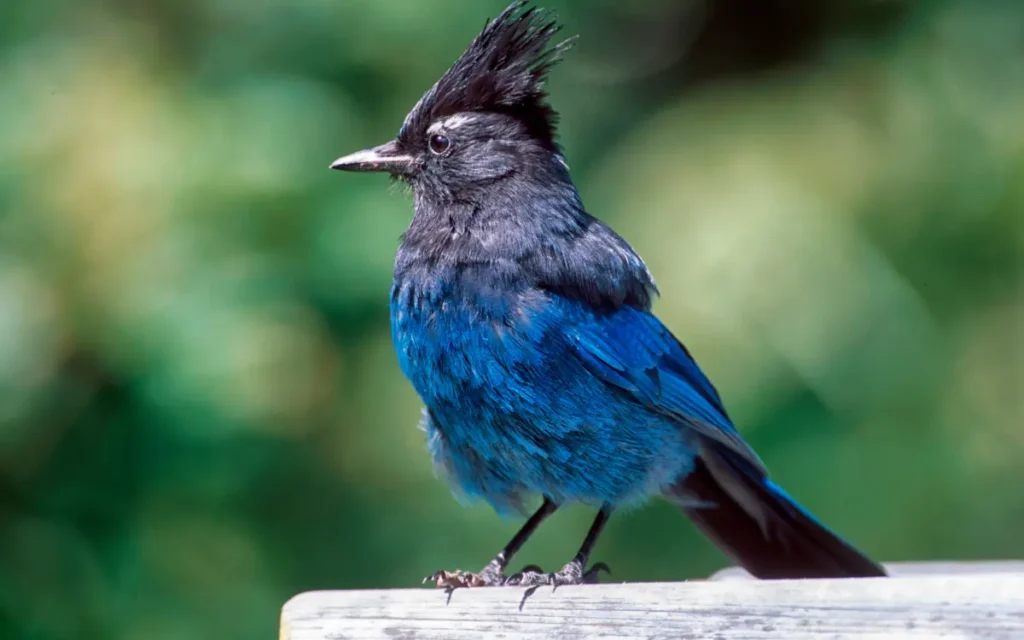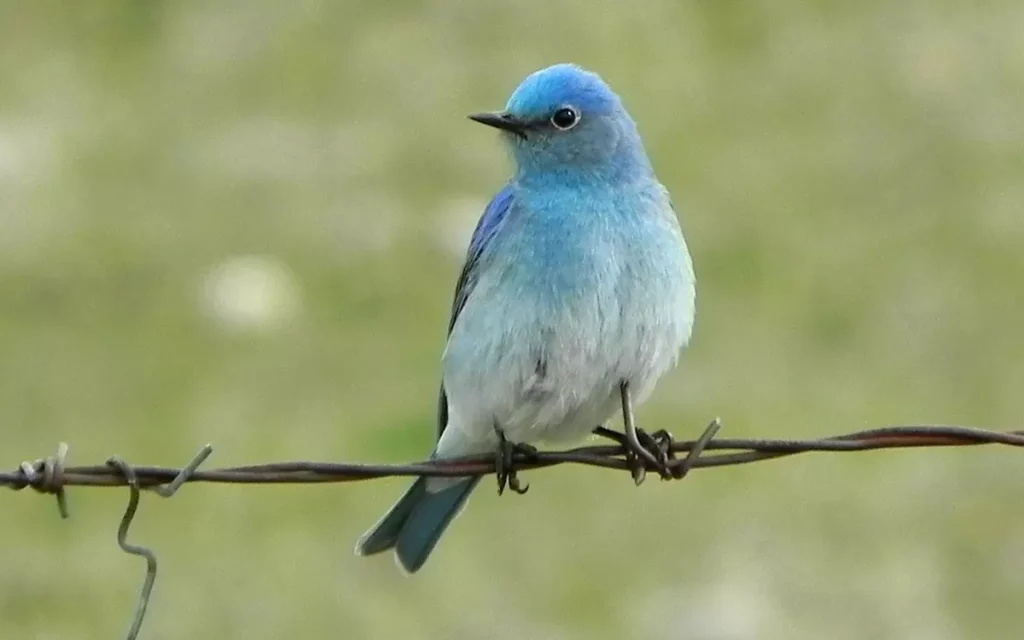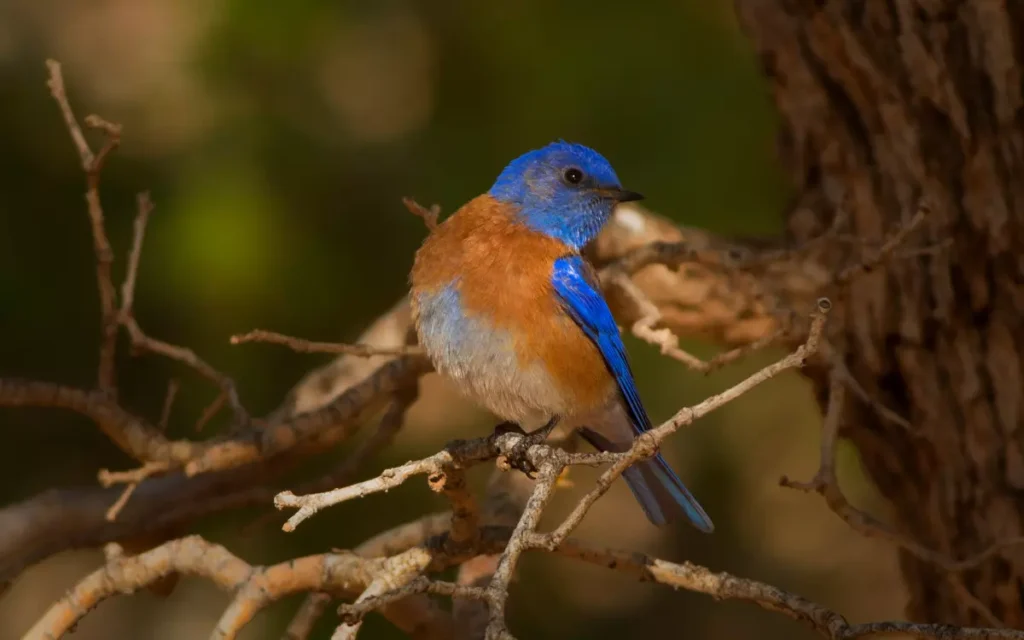15 Blue Colored Birds of Texas Identification

Blue-colored Birds in Texas, like the Eastern Bluebird and the rare Mountain Bluebird, showcase stunning hues. They provide a lovely sight for birdwatchers and make the Texas wildlife more beautiful with their lively colors.
Popular Blue Colored Birds of Texas full List :
| Bird Name | Color Description |
| Steller’s Jay | Deep blue with a black head and upper body |
| Indigo Bunting | Bright blue overall |
| Purple Gallinule | Iridescent purple-blue with green back and yellow legs |
| Mountain Bluebird | Bright blue with a lighter underbelly |
| Blue Grosbeak | Deep blue with black wings and tail |
| Mexican Jay | Blue-gray with a lighter underbelly |
| Western Bluebird | Deep blue with a rust-orange chest |
| Purple Martin | Dark blue-purple overall |
| Cerulean Warbler | Sky-blue with streaked underparts |
| Tree Swallow | Iridescent blue-green above and white below |
| Ringed Kingfisher | Blue-gray with white collar and rust-orange belt |
| Blue-gray Gnatcatcher | Blue-gray with a long tail and noticeable eye ring |
| Lazuli Bunting | Bright blue with white underparts and rust-orange chest |
| Black-throated Magpie-Jay | Blue with white belly and long tail feathers |
1.Steller’s Jay – (Cyanocitta stelleri):

Have you met the Steller’s Jay? With its bright blue feathers and a black cap-like crest, it’s hard to miss! This bird is not just about looks; it’s a clever mimic of other bird sounds. When it’s time for a home, they choose tall trees and craft nests using twigs and moss.
They love the pine forests of Texas. Here’s something cool: they lay 3 to 5 eggs, and once the babies are born, both mom and dad help in feeding and protecting their little ones.
- Length : 12 –13 in (30 – 34 cm)
- Weight : 3.5 – 4.9 oz (100 –140 gm)
- Wingspan: 17 – 19 in (43 – 49 cm)
2. Indigo Bunting – (Passerina cyanea):

The Indigo Bunting is a tiny bird, but it shines bright with its all-blue body. These night travelers use stars as their guide. They prefer building nests in low shrubs, carefully using grass and twigs.
If you’re in Texas’s open woodlands, you might hear their song! Mama bunting lays 3 to 4 eggs. And the baby care? Both parents take turns feeding their chicks, making sure they grow up strong and healthy.
- Length : 4.7 – 5.1 in (12 -13 cm)
- Weight : 0.4 – 0.6 oz (12 -18 gm)
- Wingspan: 7.5 – 8.7 in (19 – 22 cm)
3. Purple Gallinule – (Porphyrio martinicus):

The Purple Gallinule is a vibrant bird with a mix of blue-green and purple feathers. It has a red beak and yellow legs, which make it stand out. These birds build their nests in wet areas using reeds and grasses.
In Texas, they are mainly found in marshes and wetlands. They usually lay up to 7 eggs. The parents take turns warming the eggs and feeding the chicks once they hatch.
- Length : 10 –15 in ( 26 – 37 cm)
- Weight : 5.0 –10.8 oz(141–305 gm)
- Wingspan: 10 –15 in( 26 –37 cm )
4. Mountain Bluebird – (Sialia currucoides):

The Mountain Bluebird is a beautiful blue bird with a lighter belly. Its bright color easily distinguishes it from other birds.These birds prefer open areas and make their nests in tree cavities or nest boxes.
In Texas, they can be found in open fields and meadows.They lay around 4 to 6 eggs. Both parents help in feeding and taking care of the chicks until they are ready to fly.
- Length : 6.3 – 7.9 in (16 – 20 cm)
- Weight : 0.85 –1.31 oz (24 – 37 gm)
- Wingspan: 11.0 -14.2 in (28 – 36 cm)
5. Blue Grosbeak – (Passerina caerulea):

Introducing the Blue Grosbeak, a star of the Texan skies! With its deep blue body and rusty wingbars, it’s a sight to behold. These birds have a neat trick: they weave their nests in shrubs or trees, using grass and twigs.
In Texas, they love open woodlands and brushy areas. A typical Blue Grosbeak nest will have 3 to 5 eggs. And the best part? Both parents chip in, feeding and taking care of their chicks until they’re ready to spread their wings.
- Length : 5.5 – 7.5 in (14 – 19 cm)
- Weight : 0.92 – 1.11 oz (26 – 31.5 gm)
- Wingspan: 10 – 11 in (26 – 29 cm )
6. Mexican Jay – (Aphelocoma wollweberi):

Meet the Mexican Jay, a blue-gray beauty with a mischievous sparkle in its eyes. They’re social birds and often hang out in noisy groups. When it’s nesting time, they pick oak or pine trees and craft a sturdy nest using twigs.
You can spot these jays in the canyons and forests of Texas. A mama Mexican Jay lays around 4 to 6 eggs. The entire flock gets involved in chick care, making sure the little ones are safe and well-fed. It’s teamwork at its best!
- Length : 11 – 13 in (28 – 33 cm)
- Weight : 2.3 – 4.3 oz ( 65 – 122 gm)
- Wingspan: 13.4 – 16.9 in (34 – 43 cm)
Related article:
- 41 Species of Ducks Found in Texas (Identification, Calls)
- 34 Yellow Breast Birds in Texas (ID And Song Guide)
7.Western Bluebird – (Sialia mexicana):

Say hello to the Western Bluebird! This bird flaunts a rich blue coat with a touch of rusty orange on its chest. It’s a real Texan gem. These birds are expert nesters, often choosing tree cavities or even birdhouses.
Roaming the open woodlands of Texas, they lay around 4 to 6 eggs. The best part? Both mom and dad share duties, feeding and guarding their chicks until they’re ready to take on the Texan skies.
- Length : 5.9 – 7.1 in (15 – 18 cm)
- Weight : 0.84 – 1.09 oz (24-31 gm)
- Wingspan: 11.4 -13.4 in (29 – 34 cm)
8.Purple Martin – (Progne subis):

Up next is the Purple Martin, a dark, glossy blue bird that’s a treat to watch. These aerial acrobats love to swoop and dive in the air. They have a unique home choice:
gourds or multi-compartment birdhouses!
Found across Texas, they lay about 4 to 6 eggs. Parenting is teamwork here, with both parents feeding their young and teaching them the art of flight.
- Length : 7.5 – 7.9 in (19 – 20 cm)
- Weight : 1.6 – 2.1 oz (45 – 60 gm)
- Wingspan: 15.3 – 16.1 in (39 – 41 cm).
9. Cerulean Warbler – (Setophaga cerulea):

The Cerulean Warbler is a sky-blue wonder. They’re known for their rapid, buzzy songs and nimble movements. These birds make high nests in tall trees, especially in the forests of Texas.
A mama warbler will lay 3 to 4 eggs, and both parents pitch in, feeding and taking care of their chicks, ensuring they grow up ready for their own Texas adventures.
- Length : About 4.3 in (11 cm)
- Weight : 0.3 – 0.3 oz (8 -10 gm)
- Wingspan: About 7.9 in (20 cm)
10. Tree Swallow – (Tachycineta bicolor):

The Tree Swallow! This sleek bird shines with iridescent blue-green feathers. They’re super agile in the air, catching insects on the go. They prefer nesting in tree cavities or even in man-made boxes.
Texas’s open fields and wetlands are their favorite spots. A nest typically has 4 to 7 eggs. Once hatched, both parents are on duty, feeding and protecting their tiny chicks until they’re ready to fly.
- Length : 4.7 – 5.5 in (12 – 14 cm)
- Weight : 0.60 – 0.90 oz (17 – 25.5 gm)
- Wingspan: 11.8 -13.8 in (30 – 35 cm)
11.Ringed Kingfisher – (Megaceryle torquata):

The Ringed Kingfisher. With its striking blue-gray colors and loud calls, it’s hard to miss. They’re known to hover above water, diving in to catch fish. These birds dig tunnels in riverbanks for their nests.
In Texas, you’ll spot them near freshwater habitats. They lay about 3 to 5 eggs, and both parents take turns feeding their chicks, ensuring they grow up strong.
- Length : 14.2 – 16.1 in (36 – 41 cm)
- Weight : 10.8 – 12.0 oz (305 – 341 gm)
- Wingspan: 7.28 – 8.31 in (18.49 – 21.10 cm)
12. Blue-gray Gnatcatcher – (Polioptila caerulea):

The tiny Blue-gray Gnatcatcher. This bird, with its soft blue-gray feathers and twitching tail, is always on the move, hunting for insects. They build cup-shaped nests high in trees using lichens and spiderwebs.
These agile birds love the woodlands of Texas. A typical nest has about 4 to 5 eggs. Both mom and dad work tirelessly, feeding their chicks and guarding the nest from any threats.
- Length : 3.9–5.1 in (10–13 cm)
- Weight : 0.18–0.25 oz (5 – 7 gm )
- Wingspan: About 6.3 in (16 cm)
13. Lazuli Bunting – (Passerina amoena):

Meet the Lazuli Bunting, a small bird with a big splash of blue. Its bright blue head and back combined with a white belly make it look like a tiny piece of the sky. These cuties build cup-shaped nests using grass, usually hiding them in shrubs.
In Texas, you can find them in open woods and near streams. A mama Lazuli Bunting will lay about 3 to 4 eggs. And guess what? Both parents take turns feeding
and caring for their chicks, ensuring they grow up safe and healthy.
- Length : 5.1 – 5.9 in (13 – 15 cm)
- Weight : 0.5 – 0.6 oz (13 – 18 gm)
- Wingspan: About 8.7 in (22 cm)
14. Black-throated Magpie-Jay – (Calocitta colliei):

Now, the Black-throated Magpie-Jay is a real showstopper! With its long tail feathers, blue body, and a striking black throat, it’s hard not to notice. They prefer building nests on tall trees using twigs and leaves.
These jays are commonly spotted in the northern parts of Texas. A typical nest will have around 4 to 6 eggs. Once the chicks hatch, both parents get busy, feeding them and teaching them the ways of the Texan skies.
- Length : 23.0 – 30.1 in (58.5 – 76.5 cm )
- Weight : 7.9 – 8.9 oz (225 – 251 gm)
- Wingspan: 20.5 – 24 in (52 – 61 cm).
Conservation Efforts in Texas:
Protecting our blue-colored birds in Texas is crucial. These birds not only add beauty to our skies but play key roles in our environment. Thankfully, Texas has taken steps to conserve them.
Efforts include creating bird-friendly habitats, regulating hunting, and running awareness campaigns. The results? Many bluebird populations are stabilizing, and some are even increasing. It’s proof that when we work together, nature thrives!
Threats to the Blue Birds of Texas:
But it’s not all smooth flying for our blue friends. Environmental changes, like deforestation and pollution, are shrinking their homes.
Plus, they face threats from predators like cats and larger birds. With these challenges, it’s more important than ever to keep supporting conservation efforts and ensure these birds continue to grace our Texas skies.
FAQs :
Q: What birds in Texas are blue?
A: Texas boasts many bluebirds, like the Blue Grosbeak, Lazuli Bunting, and the Western Bluebird.
Q: Where are Bluebirds found in Texas?
A: Bluebirds, especially the Western Bluebird, love Texas’s open woodlands, meadows, and forest edges.
Q: What is the blue GREY bird in Texas?
A: That’s likely the Blue-gray Gnatcatcher, known for its soft blue-gray feathers and lively nature.
Q: Which bird is blue in Colour?
A: Several birds are blue, like the Indigo Bunting, Mountain Bluebird, and Cerulean Warbler, to name a few.
Q: Small blue birds in Texas?
A: The Blue-gray Gnatcatcher and Lazuli Bunting are smaller blue birds you’ll find in Texas.
Q: Large blue birds in Texas?
A: The Black-throated Magpie-Jay is a large, striking blue bird commonly spotted in northern Texas.
Q: How can I attract blue-colored birds to my garden?
A: Plant native trees, provide birdhouses, and set up birdbaths. Bluebirds love a welcoming environment!
Conclusion:
In Texas, we discovered blue-colored birds that beautify the sky and help the environment. Let’s protect them by supporting conservation, making bird-friendly gardens, or just enjoying their beauty. Each blue bird is a magical part of nature to cherish.






